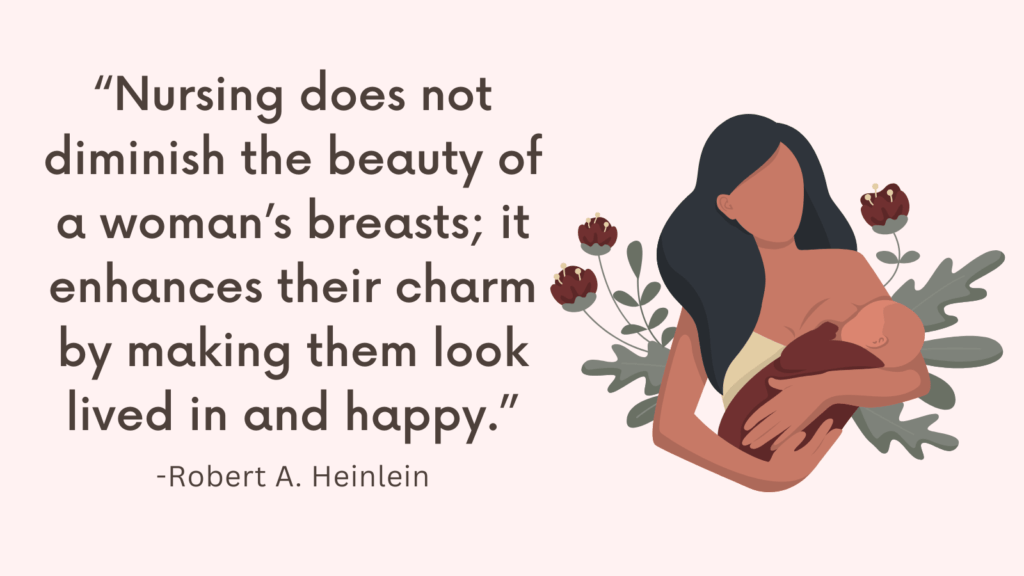In this post, you’re going to learn how to sleep comfortably with engorged breasts.
What Are Engorged Breasts?
Engorged breasts refer to the condition wherein the breasts become overly full and swollen due to the accumulation of milk in the breast tissue.
This commonly occurs in lactating women who may experience a sudden increase in breast milk production or are unable to empty their breasts properly. (source)
Engorgement can cause discomfort, pain, and inflammation of the breast tissue, making it harder for the baby to latch on.
Related: 10 Tips For Successful Breastfeeding
How Engorged Breasts Can Affect The Quality Of Sleep
Engorged breasts can significantly affect the quality of sleep of a breastfeeding mother.
When breasts are over-full, they can become heavy, swollen, and tender, making it uncomfortable to lie down in a sleeping position.
This discomfort can make it difficult for a mother to fall asleep and stay asleep.
Additionally, engorgement can lead to breast pain, which can further disrupt sleep.
Engorgement can also contribute to mastitis, a painful infection of the breast tissue. (source)
If a mother is experiencing mastitis symptoms such as fever, chills, and flu-like symptoms, these can also significantly impact her ability to sleep.
Related: How To Combine Breastfeeding And Pumping?
Causes of Engorged Breasts
Engorged breasts occur when the breasts become overly full with milk.
This often happens in the early days after giving birth, as the milk supply is still adjusting to the baby’s needs and breastfeeding routine.
Some possible causes of engorged breasts include:
1. Delayed feedings: If a baby isn’t feeding often enough, or if they’re only nursing for short periods of time, milk can build up in the breasts and cause them to become engorged.
2. Breastfeeding difficulties: If a baby is having trouble latching onto the breast, or if there’s an issue with milk transfer, the breasts may not be fully emptied during feedings, leading to engorgement.
3. Skipping feedings: If a breastfeeding mother misses a feeding or goes too long between feedings, the breasts may become overly full and engorged.
4. Suppressed milk flow: If there is an issue with the milk let-down reflex, milk may not be flowing properly out of the breasts, leading to engorgement.
5. Sudden weaning: When a breastfeeding mother weans her baby from breastfeeding suddenly, milk production slows down or stops, leading to engorgement.
6. Hormonal changes: In some cases, hormonal changes in the body (such as during menstruation or pregnancy) can also cause breast engorgement.
(source)
Related: Top 8 Breast Pumping Tips For New Moms
Risks of Sleeping With Engorged Breasts
Sleeping with Engorged breasts can be uncomfortable and even painful for some women.
Some potential risks of sleeping with Engorged breasts include:
1. Discomfort and pain: Engorged breasts can be painful, especially if they are pressed against the mattress or if you sleep on your stomach. This can cause discomfort, pain, and even lead to disrupted sleep.
2. Blocked milk ducts: If breasts are not drained regularly, milk can build up in the milk ducts and cause a blockage, leading to infection in some cases.
3. Mastitis: If a blocked milk duct is not treated, it can lead to mastitis, which is an infection of the breast tissue. Symptoms include fever, flu-like symptoms, and a red, swollen, painful breast.
4. Reduced milk production: Engorgement can also lead to decreased milk production if the breast tissue becomes too full and doesn’t have enough space for new milk to be produced.
Related: How To Increase Milk Supply During Period?
How To Sleep Comfortably With Engorged Breasts?
#1. Wear a Supportive Bra
A well-fitted and supportive bra can help reduce discomfort and provide some relief from the pressure caused by engorgement.
Make you avoid underwires which can constrict milk flow.
Choosing a supportive bra for breastfeeding involves considering a few factors:
1. Size: The bra should fit well and accommodate changes in breast size that occur during breastfeeding.
2. Support: Look for bras that provide adequate support to prevent discomfort. A supportive bra will have wider straps and full-coverage cups.
3. Comfort: Choose a bra made of soft and breathable materials like cotton, bamboo, or modal, which are gentle on sensitive skin. The bra should also be comfortable enough to wear for extended periods without causing irritation or pain.
4. Functionality: Consider bras that allow for easy access to the breast for nursing. Bras with drop-down cups or clips make it easier to nurse your baby quickly and discreetly.
5. Style: There are many different styles of nursing bras available, including sports bras, wire-free bras, and plunge bras. Choose a style that fits your personal preferences and needs.
Overall, the best supportive bra for breastfeeding is one that provides comfort, support, and functionality, while fitting well and accommodating changes in breast size.
#2. Apply Heat or Cold Compresses
If you are experiencing engorgement in your breasts, both heat and cold compresses can be helpful in relieving discomfort.
For initial relief, a cold compress can help to reduce inflammation and swelling.
You can use a cold pack or a bag of frozen vegetables wrapped in a towel and apply it to your breasts for 10-15 minutes at a time, several times a day.
Once the initial discomfort has subsided, a warm compress may be more soothing and can help to increase blood flow to the breast tissue to relieve engorgement.
You can use a warm compress such as a warm damp towel or a heating pad for 10-15 minutes before nursing or pumping. Be careful not to overheat the breast tissue and cause burns or discomfort.
Related: Best 10 Breastfeeding Books
#3. Try Different Sleeping Positions
There are a few recommended sleeping positions if you’re dealing with engorged breasts:
1. On your side: Lie on your side with a pillow between your knees and another pillow to support your head and neck, then use another pillow or rolled-up towel to support your top breast. This position will allow your breasts to hang naturally and promote drainage.
2. On your back: Lie flat on your back with a pillow under your head and neck. Place another pillow under your knees to reduce the pressure on your lower back. Use a rolled-up towel or small pillow under each arm for comfort.
3. Semi-reclined: Prop yourself up with pillows or a wedge so that you’re in a semi-upright position. This can help to reduce pressure on your breasts and may make it easier for you to breathe comfortably.
4. On your stomach: If you are comfortable sleeping on your stomach, try doing so with a pillow under your hips and chest. This will help reduce the pressure on your breasts and promote drainage.
Remember to wear a comfortable and supportive bra to bed that will help to keep everything in place and prevent any discomfort.
#4. Express Milk Before Sleeping
Expressing a little milk before sleeping can help to relieve some of the pressure and discomfort in your breasts, making it easier for your baby to feed during the night.
To express milk, you can use a breast pump or hand express.
Start by gently massaging your breasts to stimulate let down, then place the pump or your fingers around your nipple and begin to express.
Aim to remove just enough milk to make yourself comfortable, without completely emptying your breasts. You can store any excess milk in the refrigerator or freezer for later use.
Remember, expressing milk should not replace breastfeeding.
It’s important to continue to breast feed your baby regularly and seek support from a lactation consultant if you’re experiencing difficulties.
Related: Breastfeeding Resources (Information, Apps, Books, Podcasts)
#5. Breastfeed Frequently
Breastfeeding frequently can help with Engorged breasts. When your baby breastfeeds, it helps to stimulate milk production and also relieves the pressure that can cause breast engorgement.
It’s important to maintain a consistent feeding schedule, which may mean breastfeeding more frequently than usual.
You can also try using warm compresses or taking a warm shower before breastfeeding to promote milk flow.
#6. Use A Breast Pump If Necessary
A breast pump can help to relieve the pressure and reduce the engorgement.
It can also help to stimulate milk production and maintain milk supply.
It is important to follow proper pumping techniques and to avoid over-pumping as this can also cause discomfort and lead to further engorgement.
Consult with a lactation consultant or healthcare provider for guidance on using a breast pump.
Related: Best 10 Postpartum Books
#7. Take Pain Relief Medication
In some cases, pain relief medication may be necessary to manage severe pain or inflammation.
If you do choose to take medication, it is important to consult with your healthcare provider first to determine the best course of action.
Related: 10 Best Books For New Moms
How To Massage Engorged Breasts?
Massaging engorged breasts can help to relieve discomfort, encourage milk flow, and prevent complications such as mastitis.
Here is a guideline on how to massage engorged breasts:
1. Use warm compress: Take a warm towel or soak your breasts in warm water for a few minutes before massaging. This helps to soften the breast tissue and prepare it for massage.
2. Choose a comfortable position: Lie down on your back or sit in a comfortable position. Make sure you are relaxed and comfortable.
3. Use gentle movements: Starting from the breast bone, use gentle circular motions with your fingertips to massage the breast towards the nipple. Avoid pressing too hard or tugging on your nipple.
4. Massage in different directions: You can also massage in different directions such as straight up towards your collar bone or outward towards your under arm.
5. Repeat the process: Massage each breast for about 10-15 minutes, or until the breast feels softer and more comfortable.
6. Express milk: After mass aging, express some milk by hand or using a pump. This helps to relieve pressure and further stimulate milk flow.
Remember, it’s essential to maintain good breast hygiene. Keep your nipples clean and dry and avoid tight-fitting bras or clothing that may put pressure on your breasts.
When to Seek Medical Help for Engorged Breasts?
If you are experiencing Engorged breasts after giving birth, it’s important to monitor your symptoms and seek medical help if necessary.
Here are some general guidelines for when to seek medical help for engorged breasts:
1. Persistent pain that lasts beyond a few days.
2. Breastfeeding difficulties– if you are having trouble nursing your baby due to Engorged breasts, or your baby is having difficulty latching on.
3. Fever or flu-like symptoms– if you develop a fever or experience flu-like symptoms( such as chills, body aches, and fatigue), this may be a sign of a breast infection.
If you experience any of these symptoms while dealing with engorged breasts, it’s important to speak with your healthcare provider right away.
They can help diagnose the underlying cause and recommend appropriate treatment options.
Related: Best 10 Books For Working Moms
Conclusion
Engorgement is a common condition that occurs when the breasts become overfilled with milk, causing them to feel heavy, swollen, painful or hot to the touch.
While engorgement can be uncomfortable, it is usually temporary and resolves on its own within a few days.
However, in some cases, engorgement can be a sign of a more serious condition such as mastitis, a breast infection that requires medical treatment.
If you experience any of these symptoms, it is important to seek medical help immediately.




